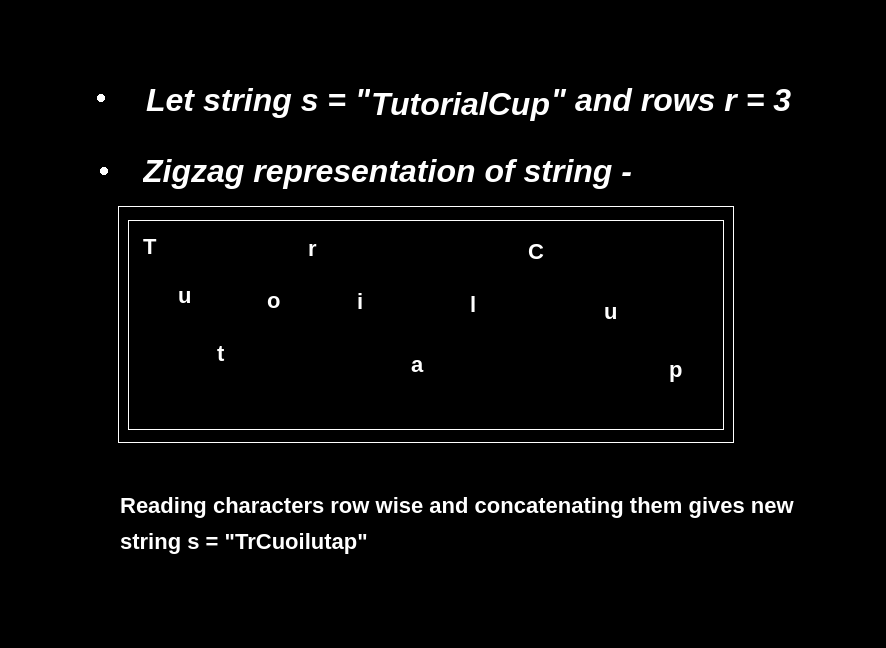In the Zigzag Conversion problem, we have given a string s of length n and an integer r representing the number of rows. Convert the given string in the zigzag pattern of r rows and concatenate the characters row-wise. Print the new concatenated string.
Table of Contents
Example
Input :
s = “TutorialCup”
r = 3
Output : TrCuoilutap
Input :
s = “Programming”
r = 4
Output : Pmramoriggn
Explanation for Zigzag Conversion
Let string s = “TutorialCup” and the number of rows i.e. r = 3
Initialize a string array a[ ] of size r to form the zigzag pattern. Also, initialize an integer variable row to track the current row as 0 and a boolean variable down.
Start traversing the string and update the string array as follows. Below are steps for the above example –
- 1 : row = 0, down = true, a[ ] = T
- 2 : row = 1, down = true, a[ ] = T, u
- 3 : row = 2, down = false, a[ ] = T, u, t
- 4 : row = 1, down = true, a[ ] = T, uo, t
- 5 : row = 0, down = true, a[ ] = Tr, uo, t
- 6 : row = 1, down = true, a[ ] = Tr, uoi, t
- 7 : row = 2, down = false, a[ ] = Tr, uoi, ta
- 8 : row = 1, down = true, a[ ] = Tr, uoil, ta
- 9 : row = 0, down = true, a[ ] = TrC, uoil, ta
- 10 : row = 1, down = true, a[ ] = TrC, uoilu, ta
- 11 : row = 2, down = false, a[ ] = TrC, uoilu, tap
Therefore, the resulting string is TrCuoilutap
Algorithm for Zigzag Conversion
- Initialize a string s of length n and an integer r representing the number of rows.
- If the given number of rows(r) is 1 return string.
- Create an array of size r of string type.
- Initialize row as 0 and down of boolean type.
- Traverse from 0 to n-1 and store the characters of a string in string array at index row.
- Check if the row is equal to r-1 update down as false.
- Else if the row is 0 updates down as true.
- If down is true increment the row else decrement the row.
- Print the updated string array.
C++ Program for zigzag conversion
#include<bits/stdc++.h>
using namespace std;
void ZigZag(string s, int r){
if(r == 1){
cout<<s;
return;
}
int n = s.length();
string a[r];
int row = 0;
bool down;
for(int i=0; i<n; ++i){
a[row].push_back(s[i]);
if(row == r-1)
down = false;
else if (row == 0)
down = true;
(down)? (row++): (row--);
}
for(int i=0; i<r; ++i)
cout<<a[i];
}
int main(){
string s = "TutorialCup";
int r = 3;
ZigZag(s, r);
return 0;
}TrCuoilutap
Java Program for zigzag conversion
import java.util.Arrays;
class Concatenate{
static void ZigZag(String s, int r){
if(r == 1){
System.out.print(s);
return;
}
char[] str = s.toCharArray();
int n = s.length();
String[] a = new String[r];
Arrays.fill(a, "");
int row = 0;
boolean down = true;
for(int i=0; i<n; ++i){
a[row] += (str[i]);
if(row == r-1){
down = false;
}
else if(row == 0){
down = true;
}
if(down){
row++;
}
else{
row--;
}
}
for(int i=0; i<r; ++i){
System.out.print(a[i]);
}
}
public static void main(String[] args){
String s = "TutorialCup";
int r = 3;
ZigZag(s, r);
}
}TrCuoilutap
Complexity Analysis for Zigzag Conversion
Time Complexity: O(n) where n is the size of the input string.
Auxiliary Space: O(n) because we store the answer in an array(of type string) while computing the answer.
